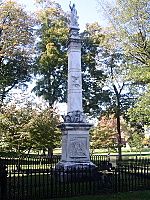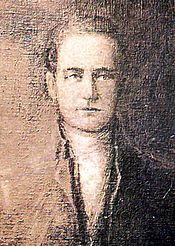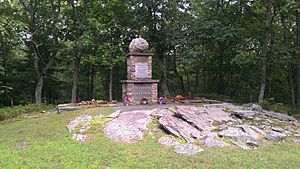Battle of Minisink facts for kids
Quick facts for kids Battle of Minisink |
|||||||
|---|---|---|---|---|---|---|---|
| Part of the American Revolutionary War | |||||||
 Monument in Goshen, New York over mass grave of Minisink battle dead |
|||||||
|
|||||||
| Belligerents | |||||||
Iroquois Confederacy |
|||||||
| Commanders and leaders | |||||||
| John Hathorn (WIA) Benjamin Tusten† |
Joseph Brant | ||||||
| Strength | |||||||
| 120 militia/elements of 4th Orange County regiment | 60 Iroquois 27 Tories |
||||||
| Casualties and losses | |||||||
| 48 killed 1 captured |
3 killed 10 wounded |
||||||
The Battle of Minisink was an important fight during the American Revolutionary War. It happened on July 22, 1779, at Minisink Ford, New York. This was the only major battle of the war in the northern Delaware Valley. The British won this battle easily. The American local soldiers, called militia, were put together quickly. They did not have good equipment and were not experienced fighters.
Brant's Surprise Attack
Most British soldiers were in New York City. But Joseph Brant, a Mohawk war chief, was sent on a special mission. He was a captain in the British Army. His job was to find food and supplies. He also needed to learn about the Delaware area near Minisink. Another goal was to stop the American Sullivan Campaign. This was a big plan by the Americans to attack Native American villages.
In June 1777, Brant learned that American forces had moved away from the Minisink Valley. This left the area open. Brant led his group of Loyalists (Americans who supported the British) and Iroquois fighters. They wanted to take supplies and make the colonists feel scared. Brant's group had 60 Native American warriors and 27 Loyalists dressed as Native Americans. The settlers had to run away to safer places.
On July 20, Brant's group attacked Peenpack. Brant gave a clear order: "They should not kill any women or children" or Loyalists. He also said to take prisoners if people surrendered. His attack was very successful. After leaving Fort Decker and the town in ruins, Brant and his group moved north along the Delaware River.
The Minisink Battle Begins
Later that day, news of Brant's attack reached the village of Goshen. A group of local soldiers, called a militia, quickly formed. Lieutenant Colonel Benjamin Tusten was asked to lead them, but he did not want to. Tusten knew his men were not ready to fight the British and Iroquois soldiers. He thought they should wait for more soldiers from the Continental Army.
However, most people and the militia wanted to fight right away. They did not understand how strong the Iroquois fighters were. Tusten was outvoted and agreed to leave the next morning. They met up with soldiers from the Fourth Orange County Regiment. These soldiers were sent by George Washington from Warwick. Colonel John Hathorn led them. Colonel Hathorn took command of the whole force, which was about 120 minutemen.
On the morning of July 22, the militia got into position. They were in the hills above the Delaware River. Their plan was to surprise Brant's forces as they crossed at Minisink Ford. Hathorn split his men into three groups. One group would scout, and two groups would be the main fighters.
But before the surprise attack was ready, Captain Bezaleel Tyler III fired at a Native American scout. This warned Brant about the trap. Brant quickly moved his fighters around the sides of the two colonial groups. Many of the American soldiers ran away. Hathorn was separated from his main group. He could not get his men back together to fight. Some of his soldiers had to retreat. This left the rest of the militia surrounded and outnumbered.
After many hours of fighting, the Americans ran out of ammunition. The battle became hand-to-hand combat. The Iroquois were very good at this type of fighting. At least 48 militiamen were killed, including Tusten. Brant's men were very harsh with those who were injured or captured. One prisoner, Captain John Wood, was saved. Brant thought he was a fellow Mason, a member of a special club. Brant's group lost only about seven men. Brant wrote that three were killed and ten were wounded. Four of the wounded were badly hurt. Colonel Hathorn was badly wounded but survived. He returned to Warwick to report the loss to his leaders.
What Happened Next
After the battle, Brant and his men crossed the Delaware River. They went back to the ruins of Oquaga. This raid did not stop the Sullivan Campaign. Three weeks later, the Continental Army sent 3,000 soldiers into upstate New York. They destroyed many Iroquois villages. Brant finally lost a major battle in late August at the Battle of Newtown.
The people of Goshen could not bury their dead for 43 years. The battlefield was too far away and too dangerous. Some soldiers' wives tried to go but had to turn back. In 1822, a group was formed to go to the battlefield. They searched for the remains of the soldiers. The few bones they found were buried in a mass grave. First, they were buried in Barryville. Later, they were moved to the village of Goshen. A stone monument was built for the 100-year anniversary of the battle. It has the names of the dead soldiers carved on it.
In 1847, a burial was found in Lackawaxen, Pennsylvania. People believe these are the remains of a soldier from the Battle of Minisink. This spot is now a memorial for unknown Revolutionary War soldiers.
Today, the battle site is Minisink Battleground County Park. It is in Sullivan County, a few miles north of Barryville. It is near the Roebling Bridge. There are no buildings from the time of the battle. But the park has trails, monuments, picnic areas, and a visitors' center.



